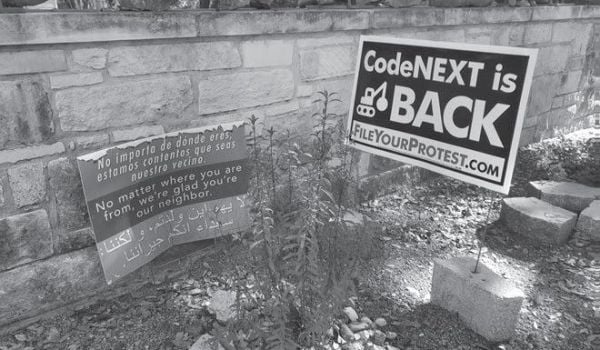Leah Goodridge has had quite a year.
In her day job as a New York City housing rights attorney, she works on behalf of tenants going through the eviction process, which re-started in January after a pandemic-induced moratorium that lasted nearly two years. Eviction systematically affects some more than others. In New York, the higher the percentage of Black or Latinx residents in a ZIP code, the higher the eviction rate. Black tenants in the city are three times more likely to face eviction than white households.
Also in January, Goodridge was appointed to serve on New York’s City Planning Commission, a 13-member body that approves rezonings and other land use changes requested by private developers as well as public agencies including the city itself. The commission meets every other week, to review applications and vote on a handful of them.
While the racialized displacement of people through evictions and rising rents in general is a huge and obvious factor in Goodridge’s day job, until recently it wasn’t required to consider when it came to rezoning applications. Commissioners and even applicants could bring up race or racism if they wanted, but it was rare that commissioners or developers brought up the potential for racialized displacement as a consequence of a rezoning. At times the argument has even gone the other way — that if not for the additional housing allowed by a rezoning, more Black or Brown people would be displaced as a result of market pressure on existing housing.
“The reality is that we do have racialized displacement,” Goodridge says. “It’s jarring. I have been a tenant rights attorney for a decade and can probably count on one hand the number of white clients I’ve had.”
Very recently, things have started to change at the City Planning Commission. After years of advocacy from tenant and racial justice advocates, in June 2021 New York City Council passed legislation requiring certain large-scale rezoning applications to include a racial equity report. That new requirement went into effect in June 2022. Some applicants started voluntarily including racial equity reports even before then, and some have done so even if they are below the square-footage thresholds that make it mandatory to include a racial equity report.
Time will tell if these changes might eventually start to make the city’s rezoning process more responsive to the concerns and needs of those whom it has long ignored. It’s still up to City Planning Commissioners or applicants themselves to bring up racial demographics or racially disparate impact from rezonings during the various conversations that happen as part of the approval process. But Goodridge says it’s coming up more and more frequently.
“What is so strange to just address that?” Goodridge says. “To say it and to have that be part of the conversation about if we have it be market rate, who’s getting displaced? What does that look like? What does that do for the community? What does that do for the culture? I think those are conversations worth having.”
New York isn’t the only city looking to better understand the racial dynamics around rezonings and other decisions made by city planning bodies. Seattle has been talking about racial equity around planning decisions for nearly two decades, and the city produced an “equity analysis” as part of its comprehensive plan update, which initiated its community engagement series earlier this month.
In Louisville, researchers at the Urban Institute just released a report on developer-initiated planning applications in that metro area. The report looks at 592 applications from 2010-2020 to understand how frequently landowners received permits for new construction and applied for rezonings, the neighborhood demographics associated with each application, and the influence of the public review process on rezoning approval rates.
Compared with a city like New York, Louisville has “a more relatable population size, distribution and development pattern given that it’s not in the upper northeast,” says Lydia Lo, research associate and co-author of the report. “So I think we’ve got a little more external validity to these findings.”
There are some similarities — like the final decisions, and where the rezoning requests come from. While Goodridge and a handful of other commissioners have voted against an application here or there, mostly for housing affordability reasons, it’s exceedingly rare for New York’s City Planning Commission to deny an application. The majority almost always votes to approve, which sends the application to city council for final approval. The Louisville Planning Commission, too, recommends approval for the overwhelming majority of rezoning applications. About 83% of developer-initiated rezoning applications in the Louisville metro area receive final city council approval.
“One of our concerns is how many rezonings are being initiated by developers,” says Yonah Freemark, senior research associate and co-author of the Urban Institute report. “What that suggests to us is that the zoning, not just in Louisville but in almost every city, does not at all correspond with what developers need to do to respond to local needs.”
Some of those needs, like the need for more housing or more economic development, are accounted for in comprehensive plans – like Louisville’s Plan 2040, which went into effect in January 2019. But actual zoning hasn’t been updated to reflect the plan.
“The zoning map and the zoning code has not yet caught up to allow for housing to be developed throughout the community in the way that reflects what people in the community have already agreed to in the comprehensive plan,” Freemark says.
The Urban Institute report categorized rezonings by purpose. Over the period studied, developers most frequently applied for approval to rezone residential properties for commercial uses. The second most-requested was residential upzoning, or zoning for greater density than current residential zoning allowed.
The pattern is in part a reflection of the fact that 73% of Louisville area land is currently zoned for single-family residential, similar to many other major cities across the country. Perhaps in alignment with Louisville’s comprehensive plan, developers are simply looking to build more commercial in areas that currently don’t have it, or build more residential in areas that are only zoned for the lowest possible residential density.
In another pattern that will be familiar to those in other major cities, developer-initiated rezoning applications in Louisville are more likely to be located in majority-white areas with above-average income and wealth.
It’s a stubborn symptom of historic redlining, the pattern of private real estate actors and the public sector systematically labeling historically Black or immigrant neighborhoods as high risk and denying them investment for decades. Even today, after it has technically been outlawed for decades, redlining still finds ways to echo across generations and make it challenging to reinvest in historically redlined areas.
“Louisville, like every city in the United States, pretty much has a racially segregated neighborhood structure,” Freemark says. “And the reality is that developers for a number of reasons are more interested in investing in communities that are whiter and higher-income.”
All that said, though only a very small percentage of rezoning applications get denied, they get denied at higher rates in wealthier neighborhoods. Though direct causation is harder to prove, data point to a connection between public sentiment and the likelihood of denial for rezoning applications in Louisville. Working with records kept by local planning officials, the Urban Institute report was able to determine that on average, one out of four public speakers opposed rezonings in wealthier neighborhoods, versus just one in ten speakers in low-income neighborhoods.
Without further research, it’s hard to say what that pattern could possibly mean. Plenty of other research and reporting supports the idea that wealthy, white homeowners are some of the most vehement opponents of new real estate development, especially if that development involves denser housing.
Lo suggests that perhaps cities with a comprehensive plan put in the work to update their zoning codes proactively instead of only reacting to developer applications.
“What needs to be done is you need to step back and say you shouldn’t even have to be going through this rezoning application process at all,” Lo says. “We should have a zoning map that equitably reflects the comprehensive plan and the need for housing development in the city as a whole.”
Digging deeper, the picture only gets more complicated. On one hand, the lack of opposition to rezoning applications in lower-income neighborhoods might be read as those neighborhoods being open to new investment that they’ve been denied for decades. But on the other hand, lack of public participation in rezoning hearings could also mean development that could lead to displacement of low-income residents can sneak by with little public discussion about that possibility. Rezoning hearings in low-income Louisville neighborhoods drew only half as many public speakers on average compared with high-income neighborhoods.
“We need to have a rebalancing of who is participating,” Lo says. “There needs to be a lower share of wealthy homeowners participating and a higher share of low income renters participating in order for us to get a sense of what housing needs to be developed in the city and what is the actual balance of benefit versus harm for the city as a whole, as opposed to just this concentrated neighborhood.”
Goodridge agrees that more participation from people who historically have been excluded from planning processes would improve outcomes for the historically excluded. Several recently controversial rezonings around New York have been approved only after a contentious process that did involve mostly Black, Latinx and Asian immigrant tenants pushing the city to fund more low-income housing created through rezonings.
But Goodridge can’t emphasize enough that planning officials, city council members voting on plans, and developers need to be able to distinguish between standard “NIMBY” (“not in my backyard”) opposition to development versus working class communities of color demanding that the development process produce new housing they can afford instead of just leaving them at the mercy of the market.
“There are people who are in favor of more housing in their area, but they would like for it to be affordable,” Goodridge says. “Those are not NIMBYs. Those are people who are in favor of development and want housing in their area, but they want to make sure that they can afford it. And the city should be funding it so we don’t run into the developer saying they can’t put any more of their money up.”
This article is part of The Bottom Line, a series exploring scalable solutions for problems related to affordability, inclusive economic growth and access to capital. Click here to subscribe to our Bottom Line newsletter.

Oscar is Next City's senior economic justice correspondent. He previously served as Next City’s editor from 2018-2019, and was a Next City Equitable Cities Fellow from 2015-2016. Since 2011, Oscar has covered community development finance, community banking, impact investing, economic development, housing and more for media outlets such as Shelterforce, B Magazine, Impact Alpha and Fast Company.
Follow Oscar .(JavaScript must be enabled to view this email address)


















